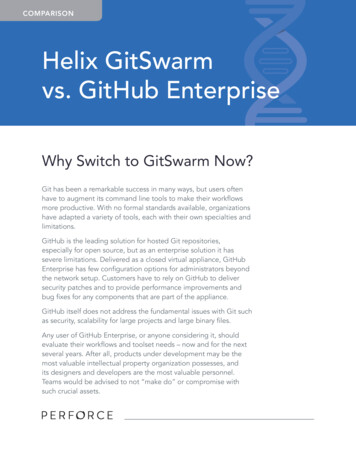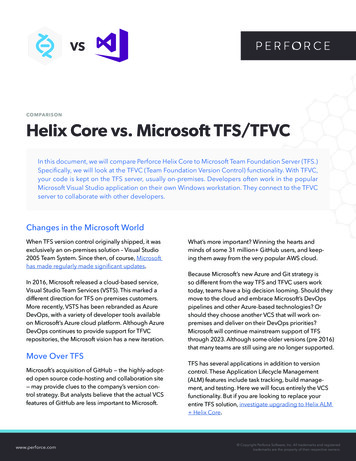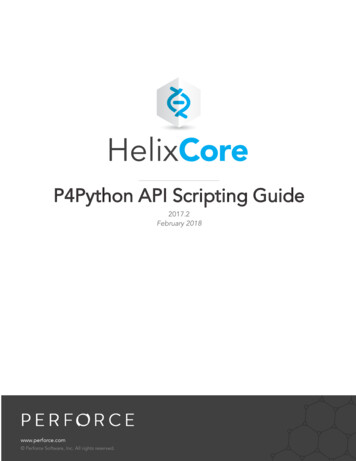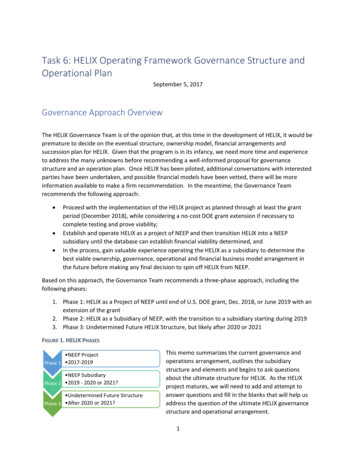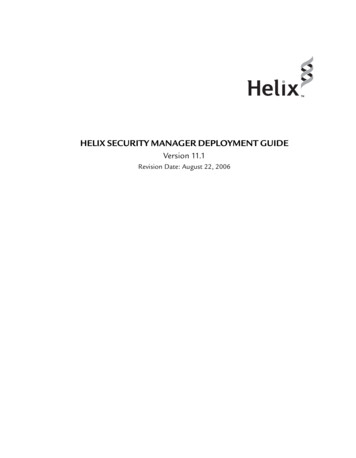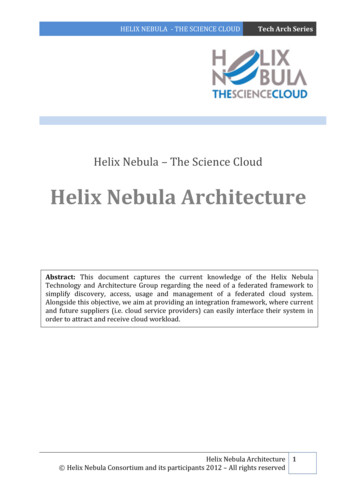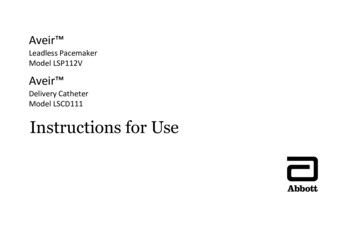
Transcription
Introducing Helix2016.2October 2016
Introducing Helix2016.2October 2016Copyright 2015-2016 Perforce Software.All rights reserved.Perforce software and documentation is available from http://www.perforce.com/. You can download and use Perforce programs, but youcan not sell or redistribute them. You can download, print, copy, edit, and redistribute the documentation, but you can not sell it, or sell anydocumentation derived from it. You can not modify or attempt to reverse engineer the programs.This product is subject to U.S. export control laws and regulations including, but not limited to, the U.S. Export Administration Regulations,the International Traffic in Arms Regulation requirements, and all applicable end-use, end-user and destination restrictions. Licensee shall notpermit, directly or indirectly, use of any Perforce technology in or by any U.S. embargoed country or otherwise in violation of any U.S. exportcontrol laws and regulations.Perforce programs and documents are available from our Web site as is. No warranty or support is provided. Warranties and support, alongwith higher capacity servers, are sold by Perforce Software.Perforce Software assumes no responsibility or liability for any errors or inaccuracies that might appear in this book. By downloading andusing our programs and documents you agree to these terms.Perforce and Inter-File Branching are trademarks of Perforce Software.All other brands or product names are trademarks or registered trademarks of their respective companies or organizations.Any additional software included within Perforce software is listed in License Statements on page 25.
Table of ContentsChapter 1Basic Concepts . 1The basics of version control . 1Helix as a version control implementation . 2Multiple user access to a set of files . 3Balancing stability and innovation: the mainline model . 4Streams . 6Organizing your work: jobs and labels . 7Working together and working apart: centralized and distributed development . 8Collaborating within a Git ecosystem . 9Helix Git Fusion . 9Helix GitSwarm . 10Performance, scaling, and high availability . 10Using proxies to improve performance . 10Using a replica for disaster recovery . 11Commit-edge architecture . 12Securing the system . 12Chapter 2Clients, Collaboration, and Security . 15Client applications .Collaboration .Helix Swarm .Helix GitSwarm .Integration .Interactive development environment integrations .Build and reporting integrations .Chapter 315151515151616Customizing and Extending Helix . 17APIs . 17Triggers . 17Helix Broker . 18Chapter 4Use Cases . 19Software development .Digital asset management .Hybrid product development .Ease of use for Helix administration .Growing into the future .Introducing Helix1919191920iii
Introducing HelixChapter 5Documentation and Other Resources . 21To learn more about Helix .Helix documentation .Syntax conventions .Please give us feedback .Download URLs .Videos .212122232323License Statements . 25ivIntroducing Helix
Basic ConceptsChapter 1This document introduces Helix, a secure, scalable, and highly available version control system thatsupports parallel development. You should read this document before you start working with Helix.This document: introduces the basic concepts and tasks of version control explains how you can configure Helix to improve performance and to scale the system suggests some ways you can extend and customize Helix explains how you can use Helix with other products to get additional functionality discusses use cases for Helix introduces the many support resources that can help you use HelixIf you are familiar with version control systems, you can skip the first section and begin by reading“Helix as a version control implementation.”The basics of version controlWhen you work alone on a document, the latest is usually the greatest: you successively open thedocument, make changes, and save the document. Each time you save, you overwrite the existingcopy. The situation is different when you are working with a large, globally distributed team ona project consisting of hundreds or even thousands of files. In this case, it is important to trackauthorship and changes, and to resolve conflicts when several users make contending changes to thesame file. Version control systems allow you to do this; you can track and manage changes to any largecollection of digital assets: documents, source code, web sites, audio files, and so on.Version control systems address these issues using a variety of techniques; one of the most basic isversioning. Rather than overwriting earlier versions of a file when it is saved, under version control,each saved copy of the file is versioned and assigned a number or letter that reflects the order in whichit was saved.In addition to identifying a file version within a sequence of versions, a version control systemautomatically associates certain information with each version: it records who made the change, whenthe change was made, and why the change was made. Taken together this information provides anaudit trail that you can always consult to understand how a project developed and when specificchanges were made. Because no version of a file is overwritten, when bugs arise, it is possible to lookback in time to identify the point at which the bug was introduced. This can be critical in fixing bugsthat cannot be reproduced. Equally, looking at file history and understanding why certain decisionswere made can help project participants stay on track or find appropriate options for future directions.Sharing data under version control requires a certain amount of gatekeeping to determine who canaccess the data and how conflicts are resolved when two users make changes to the same file. Wehave explained so far about editing and saving files; but to support this gatekeeping function, versioncontrol systems introduce the additional step of checking out a file and checking in or submitting a file.The basic version control workflow looks like this:1. Assets under version control are placed in a specified repository.Introducing Helix1
Chapter 1. Basic Concepts2. Assets are associated with specific permissions that users must have in order to read or modifythem.3. A user checks out a working copy of an asset and makes changes.4. Another user checks out a working copy of the same asset and makes changes.5. The first user saves changes to their working copy and checks in that copy.6. The second user saves changes to their working copy and checks in that copy.7. The version control system detects the fact that the same asset was changed in parallel, and it asksthe second user to merge changes with those of the first user before the second user’s changes canbe checked in. The work of comparing and merging changes is called resolving.In this way, the version control system makes sure that changes are predictable, manageable, andauditable.Version control systems are traditionally either centralized or distributed: Centralized version control systems use a single repository from which users check out one or morefiles to work on locally. Distributed version control systems allow users to host repositories locally, check out entire repositorieswith all history—or, in the case of Helix, a subset of repositories—work independently of oneanother, and combine their work through merging when necessary.Helix supports either model, as well as a hybrid of the two.Version control systems can be used as stand-alone applications or they can be incorporated intodevelopment or authoring tools as a means of managing the assets produced by these tools.Helix as a version control implementationHelix uses a client-server architecture to implement version control management. The Helix server (also known as the Helix Versioning Engine or p4d) manages shared filerepositories, or depots, that contain every revision of every file under version management. Filesare organized into directory trees. The server also maintains a database to track data associated withfiles and client activity: logs, user permissions, metadata, configuration values, and so on. Helix clients provide an interface that allows you to check files in and out of the depot, resolveconflicts, track change requests, and more.Helix clients include a command-line client, a graphical user interface client, and various pluginsthat work with commercial IDEs and productivity software. A Helix server can provide services to amix of Helix clients.You also use Helix clients to manage a special area of your computer called a workspace. Directoriesin the depot are mapped to directories in your workspace, which contain local copies of managedfiles. You always work on managed files in your workspace:1. You check the files out of the depot (and into your workspace).2Introducing Helix
Chapter 1. Basic Concepts2. You modify the files.3. You check them back into the depot.4. If the changes you try to submit conflict with changes that other users, working in parallel withyou, have already submitted, you must resolve conflicts as needed.The next figure shows the mapping between depot files (shown on the left) and workspace files(shown on the right). Until files are checked out from the depot, they remain as read-only in theworkspace. To have Helix update your workspace so that it reflects current work on the depot,synchronize your workspace to the depot by getting the latest revision of the files.We have explained about checking files in and out of the depot, suggesting that single files may bechecked in and out. In fact, the means we use to check files in and out of the depot is the changelist. Achangelist must contain at least one file and may contain tens of thousands. A changelist is numberedand allows you to track all changes with respect to the contents of the depot: file modifications, theaddition of a file, or the deletion of a file.The changelist is the simplest way to organize your work. A changelists also represents the atomicunit of work in Helix: if a changelist includes several files, changes for all the files are committed tothe depot or none of the changes are. For example, if a network connection between the client and theserver fails during changelist submission, the entire submit fails.Multiple user access to a set of filesVersion control systems must address the fundamental need for multiple users to work on the sameproject simultaneously. Helix offers two ways to do this: File locking: Helix locks a file while someone is working in it. This controls access to the file: ifseveral users want to edit the same file, it is possible to merge changes into one mutually acceptableversion. Branching and merging: By branching streams and then merging them later, multiple users canwork on the same files simultaneously. See “Balancing stability and innovation: the mainlinemodel” on page 4.Introducing Helix3
Chapter 1. Basic ConceptsBalancing stability and innovation: the mainline modelSo far, we have explained how version control systems handle the problem of different users workingon the same file at the same time: when the different copies of the file are checked in, all but the firstuser must resolve changes by deciding which changes will be preserved in the latest version of the file.This is the simplest use case for parallel development. More complicated cases arise when largedevelopment projects require many people to work in parallel both because they must supportmultiple releases and because they involve multiple functional teams working together to create thedesired product.For example, a game development company depends on the combined efforts of artists, musicians,programmers, testers, and build engineers to create a release. One way to organize this effort is tosplit the set of files that make up the project into multiple parallel branches, allowing developmentand testing to occur along each branch. Integration then occurs across branches to promote everyone’swork into a releasable product.Consider the following cases: Extremely short release cycles, such as occur with fast changing web content, require overlappingcycles of testing and release.To handle this case, we move code through the branches shown above. Development occurs alongthe development line. When a milestone is reached, code is copied up to the QA line where it isthoroughly tested. After it clears all tests, it is copied up to the Beta test line where it is subjected toreal-world use. Having satisfied Beta users, it can then be copied up to a release line. Note the purpledashed lines, which indicate the flow of code as it is copied up through the branch hierarchy. Unforeseen delays cause some features under development to miss deadlines. Not wanting toimperil the project as a whole, the project is released while development continues for the laggardcomponents.In the model shown above, projects X, Y, and Z have been branched off from the developmentmainline and worked on independently. When work has completed and projects X and Y have4Introducing Helix
Chapter 1. Basic Conceptspassed development tests, they are copied up to the mainline. Project Z however could not becompleted and work continues on that project without putting the larger release at risk.What does branching have to offer? It allows us to balance the need for stability with the need forinnovation. On the one hand, we have release branches that hold the most tested and stable code;on the other hand, we have development branches that allow for experimentation and explorationwithout putting the release at risk.Branches can be organized in a variety of ways: you can create branches for different platforms, youcan create branches along organizational lines, and so on. One common model used for productdevelopment is the Mainline model shown below:The Mainline forms the trunk from which release branches and development branches are created.Each branch normally contains a subset of the Mainline files. Release branches might contain fewerfiles because files needed for testing are excluded; development branches might contain a differentsubset of files because the projects they represent focus on discrete product features. In the Mainlinemodel, the “up” direction indicates increased stability or confidence.When you create branches, you are free to integrate changes in any direction you like. Unfortunately,this can lead to big problems if you inadvertently integrate untested changes into an otherwise stablebranch. For this reason, in addition to defining branches that isolate changes, the Mainline model ismost useful when it can implement some protocols that limit what changes can be made and in whatdirection.Introducing Helix5
Chapter 1. Basic ConceptsStreamsHelix streams implement the Mainline model, adding intelligence that determines what changes can bemade and in what order they must be made.Let’s look at the Mainline example again and add some information to indicate flow of change: Project Y has been branched from Mainline; work and testing continues until it is complete. It isthen ready to be copied back up to the mainline. However, while development has taken place inY, Mainline has continued to change. Before we can copy the contents up to the Mainline, we needto make sure that Project Y files reflect changes that have been made in Mainline; we merge thosechanges into Project Y before we copy Project Y files to Mainline. A bug is found in Release 1.x. The bug is fixed and tested. We now want the bug fix in Mainline, sowe merge files from Release 1.x down to Mainline. We do not copy anything up because Release 1.xshould not include any features added after it has been branched.The Mainline model arranges branches in terms of stability: the most stable branches are at the top; theleast stable branches are at the bottom. The flow of change needs to support this model by mergingchanges down and copying up.Typically, when you work with streams, you define and populate the mainline first. You then createdevelopment streams and release streams as children of the Mainline stream. The type of a stream andits relationship to other streams determines what sort of changes can be made and in what order theyare made.Rather than using a timeline, the streams GUI—found in the Perforce Visual Client (P4V)--representsrelated streams as shown below:6Introducing Helix
Chapter 1. Basic ConceptsThe children of Main are shown both above and below Main. Release type streams are at the top;development and task streams are at the bottom. Stability grows as streams near the top of thediagram. The direction and color of arrows linking streams indicate both the direction of flow and theorder of flow.When you create a stream, you specify its type, its relationship to other streams, and how files areto be treated for merging and branching. The information you provide is then used by the streamsapplication to encourage good behavior.Streams provide visual clues for where and how to branch and merge. They guide behavior thatsupports stability and innovation. Using streams eliminates much of the work needed to definebranches, to create workspaces, and to manage integrations.An additional advantage of using streams is that when you switch from one stream to another, thecontents of your workspace are updated automatically to reflect the contents of the current stream.Streams automate branching, but you do not have to use them. You can create your own branchesand manage them as you see fit. Custom branching gives you finer grained control but you lose theconvenience of built-in flow control and workspace updating.For information on streams, see the P4 User Guide.Organizing your work: jobs and labelsIn addition to using changelists and streams to organize your work, you can use two other methods:jobs and labels. Jobs provide lightweight issue tracking that integrates well with third party defect tracking andworkflow systems. They allow you to track the status of a bug or an enhancement request. Jobshave a status and a creator and are associated with changelists that implement the bug fix or theenhancement. An administrator can customize the type of information tracked by jobs add more finegrained status values, or define additional fields for information to be tracked: which customer theenhancement is for; what was done to test the fix, and so on.You can integrate the jobs function with third-party defect tracking and workflow systems. For moreinformation, see the Defect Tracking Gateway page.Introducing Helix7
Chapter 1. Basic Concepts Labels are sets of tagged file revisions that allow you to handle a heterogeneous group of files asone unit. While a changelist refers only to the contents of a given set of files at the time they weresubmitted, a label can refer to a group of file revisions from different points in time. You might wantto use labels to define the group of files contained in a particular release, to sync a set of files, topopulate a workspace, or to specify a set of file revisions to be branched. You can also use a label asan alias for a changelist number, which makes it easier to remember the changelist and easier to referto it in issuing commands.For information about jobs and labels from a user’s perspective see the P4 User Guide.For information about managing jobs and labels, see the Perforce Server Administrator Guide:Fundamentals.Working together and working apart: centralized and distributeddevelopmentWe mentioned earlier that version control systems can implement either a centralized model or adistributed model: Centralized version control systems use a single repository from which users check out one or morefiles to work on in their local directories. Distributed version control systems allow users to host repositories locally, check out entire repositorieswith history—or, in the case of Helix, a subset of repositories—work independently of one another,and combine their work through merging when necessary.Helix supports either model, as well as a hybrid of the two.In the centralized model, clients work with a depot on a shared server. A mapping of files from thedepot to their workspace determines which files they are able to work with in their workspace. Thefollowing figure illustrates the centralized model:Users check files out of the same depot, work on them, and check in their changed files. If multipleusers work on the same file, they use merging and conflict resolution to make sure the resultingversion is satisfactory to all authors. Although users can disconnect from the shared server and8Introducing Helix
Chapter 1. Basic Conceptscontinue to work on the files in their workspace, some manual work is required to sync back to theserver and to check in files when the user reconnects. For information on working with Helix usingthis model, see the P4 User Guide.In the distributed model, users work with a depot on personal servers that are then connected to ashared server. The depot on their personal server might contain a subset or the entire set of files on theshared server. Each user can work disconnected from the shared server but still be able to access all thefiles in their workspace and place these under version control using their personal server. Each usercan access the entire history of a file locally, can rewrite and revise history, and can manage the filesand streams on their local machine without interacting with the shared server.The following figure illustrates this model:When users decide to share their code or digital assets with other users, they connect to and then pushtheir content to the shared server. This allows other users to fetch that content from the shared serverand work with it on their own personal server. Users might need to merge content before pushing iftheir changes conflict with changes made by others.In addition to supporting these two models, Helix also allows for a hybrid architecture in which someusers connect directly to the shared server while others connect to personal servers that are connectedto the shared server.For more information about distributed development and file management, see Using Helix forDistributed Versioning.Collaborating within a Git ecosystemGit users who want to take advantage of Helix enterprise-level features can work seamlessly withHelix Versioning Engines using Helix Git Fusion and Helix GitSwarm.Helix Git FusionHelix Git Fusion is a Git remote repository service that uses the Helix Versioning Engine as itsbackend. Git users interact with Git Fusion as they do with any other Git remote repository (repo),issuing standard Git commands to clone repos and transfer data. When a Git user pushes changes, GitIntroducing Helix9
Chapter 1. Basic ConceptsFusion translates those Git changes into Helix changes and submits them to the Helix depot. When aGit user pulls changes, Git Fusion translates the pull request into p4d commands to download changesfrom the Helix depot.Helix GitSwarmHelix GitSwarm is Perforce’s code review solution for Git users. Built on the open source productGitLab, it includes Helix-specific enhancements to support both Git and Helix code reviews. It allowsusers to push their code, review others' code, comment, and track issues.Performance, scaling, and high availabilityVersion control systems are key to managing large projects: with Helix, “large” can be large indeed.With enterprise-level features that you can use to fine tune and improve performance, Helix lets youscale your system to accommodate a global workforce, and to automate failover for a highly availablesystem. For example, Helix can accommodate the needs of a gaming development company whosefiles might take up hundreds of terabytes or even petabytes of data; or it can support the work ofa software company, whose activity level includes massive automated testing as well as focused,analytic bug fixing and tracking work.To support these tasks, Helix uses the following additional server types: Proxies are used where bandwidth to remote sites is limited; they mediate between remote clientsand the versioning service. By caching frequently used files, the proxy reduces demand on the serverand keeps network traffic to a minimum. Brokers mediate between clients and servers to implement policies that solve routing or securityproblems. Replicas duplicate server data. They can be used to provide a warm standby server or to reduce loadon a primary server.The following sections explain how these servers are used singly or how they are combined to provideenterprise-level performance. For complete information about using proxies, brokers, and replicas, seePerforce Server Administrator Guide: Multi-site Deployment.Using proxies to improve performanceTo improve performance for users accessing a shared Helix repository across a WAN, you canconfigure a proxy on the side of the network close to the users and configure the users to access theservice through the proxy; then configure the proxy to access the master Helix service.10Introducing Helix
Chapter 1. Basic ConceptsThe following diagram illustrates a typical proxy configuration:In this configuration, file revisions requested by users at a remote development site are fetchedfirst from a shared server (p4d running on Central) and transferred over a relatively slow WAN.Subsequent requests for that same revision, however, are delivered from the Helix Proxy, (p4p runningon Outpost), over the remote development site’s LAN; this architecture reduces both network trafficacross the WAN and CPU load on the shared server.Using a replica for disaster recoveryReplication is the duplication of server data from one Helix server to another. The replicated server iscalled the master server; its replica is called a replica server. You can use replication to provide a warmstandby server, or to reduce load and downtime on a primary server when performing builds. Thefollowing figure shows how you set up a replica to provide a war
Helix uses a client-server architecture to implement version control management. The Helix server (also known as the Helix Versioning Engine or p4d) manages shared file repositories, or depots, that contain every revision of every file under version management. Files are organized into directory trees.
